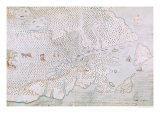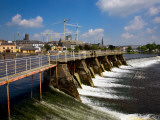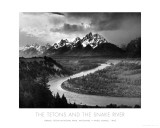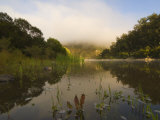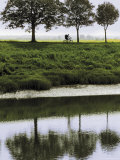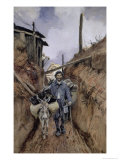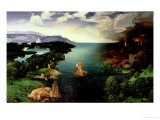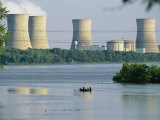|
|
|
|
|
The Saint Lawrence River runs 744 miles (1,197 km) from Lake Ontario to the Gulf of St. Lawrence, the world's largest estuary and forms a part of the international border between Canada and New York State.
The river drains 390,000 sq mi watershed from the Mesabi Range in the state of Minnesota to the Atlantic Ocean, including the Great Lakes.
In 1959 the bi-national St. Lawrence Seaway, a system of locks, canals and channels opened, permitting ocean vessels to travel from the Atlantic as far inland as the western end of Lake Superior.
In 1535 the French explorer Jacques Cartier lead the first European expedition up the St. Lawrence, which became an important passageway into the interior of North America.
Notable cities along the St. Lawrence include Montreal and Quebec City.
|
|
|
|
The River Seine derives its name the Gaul Sicauna, which means sacred river.
The Seine flows through Paris, and has been inspiration for many artists, see Alfred Sisley.
• France posters
|
|
|
|
The River Shannon is the longest river in Ireland and a major physical barrier between east and west Ireland.
The geographer Ptolemy was first to map the Shannon c. 130 AD.
FYI - a “weir” is a type of dam that usually is a barrier that causes water to pool behind the structure and flow over the top.
|
|
|
|
Snake River is the largest tributary of the Columbia River, the largest North American river that empties into the Pacific Ocean.
Ansel Adams (1902-1984), renowned nature photographer, was also a staunch champion of wilderness preservation who impacted environmentalism through his legendary and awe-inspiring photographs.
• National Parks posters
|
|
|
|
Snowy River is a major river in south-eastern Australia, originating on the slopes of Mount Kosciuszko, Australia's highest mainland peak, draining the eastern slopes of the Snowy Mountains in New South Wales, before flowing through the Snowy River National Park in Victoria and emptying into Bass Strait.
‘Banjo’ Paterson's 1890 poem “The Man from Snowy River”, is the basis of several films, a TV show, and music theater.
|
|
|
|
The Somme River, in northern France and only 245 km long, flows from Fonsommes to the Bay of the Somme in the English Channel.
Its location made the Somme the site of several historic events.
In 1066 William the Conquerer assembled his Invasion Fleet at the mouth of the Somme.
In 1415 armies crossed the Somme before the Battle of Agincourt (see William Shakespeare's Henry V).
The Battle of the Somme (July-November 1916) was one of the largest battles of the First World War where the forces involved (British and French against the Germans), had suffered more than 1 million casualties, making it one of the bloodiest military operations ever recorded. The Second Battle of the Somme in 1918 was the beginning of the end for the Germans.
FYI ~ the name Somme is Celtic and means tranquil.
|
|
|
|
The Styx, the most famous river in Greek mythology, forms the boundary between Earth and the Underworld with the rivers Phlegethon (flaming), the Acheron (pain)*, and the Cocytus (lamentation), converging at the center of the underworld in a great marsh. The word styx means “hate”.
Charon is the ferryman who carries the souls the recently dead across the Styx and Acheron, from the world of the living to the world of the dead. The common practice of placing a coin in the mouth of the deceased was the mourners way to pay Charon for the passage and not leave their loved one wandering on the river bank.
The mother of Greek hero Achilles tried to make her son invinsible by dipping him in the Styx - only his heel didn't get submersed and that is where he suffered a fatal wound - his “Achille's heal”.
The Styx has been portrayed by poets Dante Alighieri in “The Divine Comedy”, John Milton in Paradise Lost.
The other important Greek mythological rivers are the Lethe (oblivion), Eridanos, and Alpheus (whitish).
The Vaitarna River in Hindu mythology and the Sanzu River in the Japanese Buddhist tradition, serve a similar role as the Styx, in culture.
* the root of the word “ache” is from Proto-Germanic akanan, related perhaps from Proto-Indo-European (PIE) base ag-es- "fault, guilt,", also represented in Sanskrit and Greek perhaps imitative of groaning. There doesn't seem to be a direct link between the River Acheron and aching, though they both mean pain.
|
|
|
|
The Susquehanna, which rises near Cooperstown, NY and drains into the Chesapeake Bay, is regarded as one of the oldest major river systems in the world and is the longest river on the American east coast that drains into the Atlantic Ocean.
With its watershed it is the 16th largest river in the United States and the Susquehanna River Basin, one of the nation's most flood-prone watersheds, experiences on average $150 million in damages each year.
The Three Mile Island (TMI) Nuclear Reactor, near Harrisburg, PA, was the site of the most significant accident in United States commercial nuclear energy generation to date: on March 28, 1979 unit TMI-2 suffered a partial meltdown.
• Susquehanna Flood Forecast & Warning System
|
|
|
|
previous page | top | next
rivers | a-b | c | d | e-f-g-h-i-j | k-l | m | n | o | p | q-r | S | t-u-v | w-x-y-z
|
|
I have searched the web for visual, text, and manipulative curriculum support materials - teaching posters, art prints, maps, charts, calendars, books and educational toys featuring famous people, places and events - to help teachers optimize their valuable time and budget.
Browsing the subject areas at NetPosterWorks.com is a learning experience where educators can plan context rich environments while comparing prices, special discounts, framing options and shipping from educational resources.
Thank you for starting your search for inspirational, motivational, and educational posters and learning materials at NetPosterWorks.com. If you need help please contact us.
|
|
|









